#not that I don’t like the look of olive drab bdus but
Text
Broca Divide is not my favorite episode by any measure, but Daniel’s black turtleneck was so cunty.
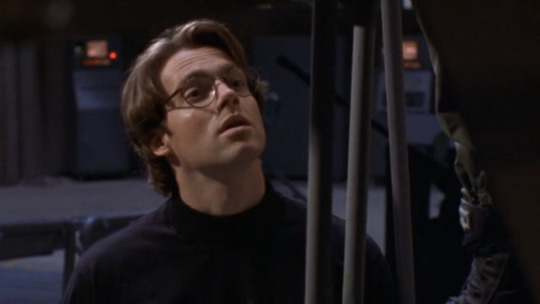
12 notes
·
View notes
Video
HAPPY STAR TREK DAY!
(although if you live in Canada, “Star Trek” day was two days ago, because the show was broadcast there first)

Today marks the 55th anniversary of the Star Trek franchise. Premiering on the NBC network at 8:30 pm, the country encountered most of the crew of the USS Enterprise for the first time in the episode The Man Trap.

Although it was the first episode broadcast, The Man Trap was actually the sixth episode produces. However, it was a good choice as a premier because it included most of the main cast as well as many of the elements that would become staples of the series.
First and foremost being the USS Enterprise, a ship unlike any other ever seen.

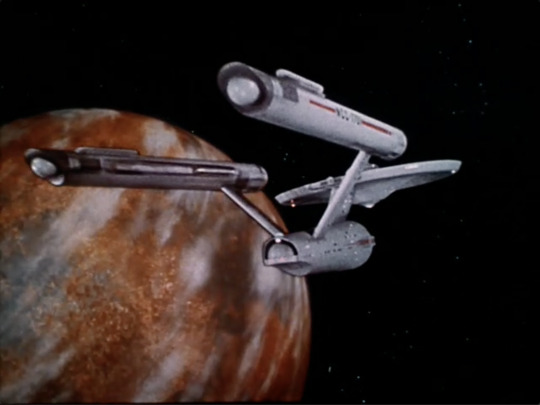

Ah, the old NCC-1701! She is a thing of beauty!

The episode, of course, opens with the familiar voice over “Captain’s log,” which was a wonderful storytelling device for setting the narrative. But even though we hear Captain Kirk’s voice first (although we don’t know his name yet), Spock is the first major character we see. The log entry informs us that Spock has been left in charge onboard the Enterprise.
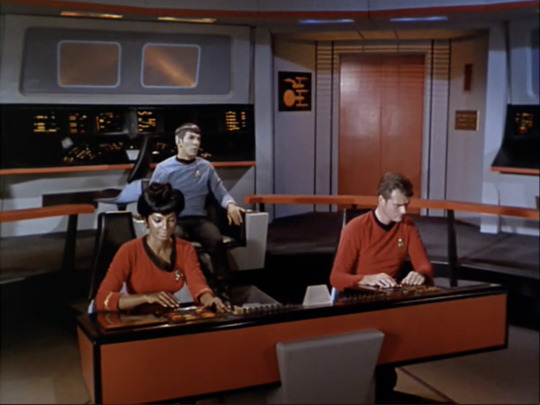
We also get our first glimpse of Lt. Uhura, seated at the navigator’s station. It won’t be until a little later that we learn that she is the communications officer for the ship. But this quick scene establishes that the Enterprise’s crew is very diverse (an alien and a Black female both on the bridge), which raised more than a few eyebrows back in 1966.

Next we get our first view of the transporter effect. There is no explanation given as to what is happening, other than Kirk’s voiceover stating that he and Dr. McCoy are “beaming down” to the planet’s surface. Star Trek, especially in the early days, decided the audience would be able to figure out what was happening.

Then we get out first look at Captain James Kirk and Dr. Leonard “Bones” McCoy. The scene immediately establishes the friendship between the two, with Kirk’s gentle teasing of his ship’s doctor. Also note, this is the shortest you’ll see Kirk’s hair in the entire series. He’s got a proper military cut here; by the end of the third season he almost looks like a hippie.
There’s also a great bit later on, when Kirk and McCoy are speaking to each other on the ship via viewscreen. McCoy tells Kirk he’s having trouble sleeping. Kirk’s reply: “Try taking one of those red pills you gave me last week. You’ll sleep!”

Throughout the episode we’ve seen Kirk as the tough, no-nonsense, by-the-book captain who commands the respect of the people he leads. But these bits with McCoy show his humorous, human side that makes him a great character. I truly miss first season Kirk, especially the first part of the season, because that’s my favorite version of him.
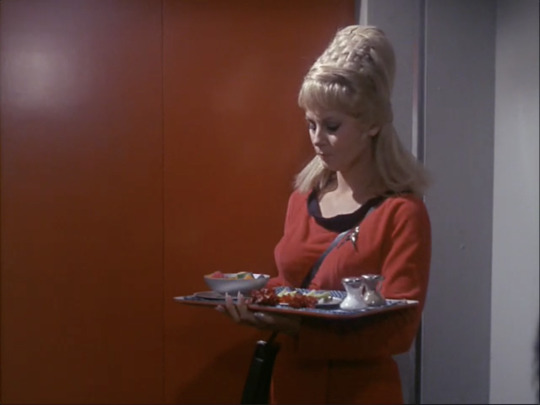
Peppered throughout the episode are shots establishing many of the other characters who will become regulars on the series. Here we have Yeoman Janice Rand, who we learn is the captain’s yeoman and quite popular among the male crew members.
Unfortunately, Yeoman Rand only appeared in eight episodes spread across the first half of the season.

Rand delivers the tray of food at the botany lab, where we meet Sulu for the first time.

Since this is the first time the audience see Lieutenant Sulu, it would be understandable if it was assumed that he was just a botanist. Actually, Sulu had a few different positions in the first season (he was a physicist in the second pilot Where No man Has Gone Before, which would be broadcast 2 weeks after The Man Trap).

Surprisingly, Lieutenant Uhura seemed to get the most screen time of all the secondary characters. (not that I’m complaining; Nichelle Nichols is absolutely gorgeous!). Earlier on the bridge she was flirting with Spock (with Spock subtly tugging on his shirt collar, indicating his discomfort), and then chastising him for his apparent lack of concern when he learned that a member of the landing party is dead. Here she is being the queen that she is, teaching two other crew members proper turbolift etiquette: you let the person in the lift get out before you get in (same goes for elevators, just in case you didn’t know).
Two other recurring characters, Chief Engineer Montgomery “Scotty” Scott and Nurse Christine Chapel, are the only two not seen in this episode. Scotty’s voice, though is heard on the communicator responding to Kirk from the transporter room. As for Nurse Chapel, she was not introduced until The Naked Time, which was the next episode (#7) produced, but the fourth to air.
One thing which I didn’t notice until I rewatched this episode just now (or maybe I did notice, but just forgot) is that Kirk is carrying a phaser almost the whole show, even while on the bridge.
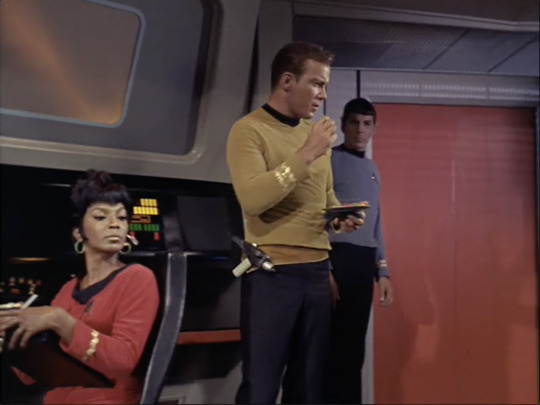

Sharp-eyed viewers may also spot various crew members in older uniforms, like those worn in the two pilots, The Cage and Where No Man Has Gone Before.
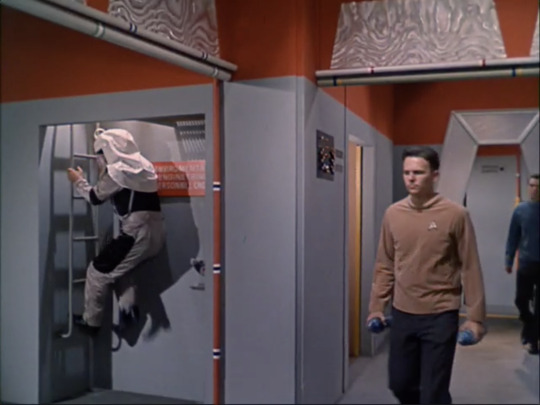
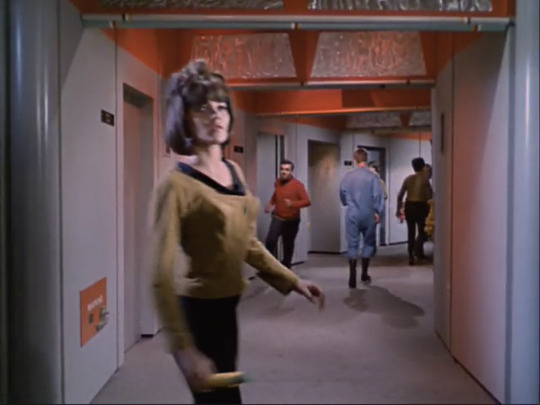

Some people may call these continuity errors, or chalk it up to the wardrobe department recycling costumes for the extras. But anyone who’s been in the military knows there’s always a transition period when new uniforms are introduced. For example, my Basic Training class was the absolute last in the Army to be issued the old olive drab green fatigues. The next class was issued the new woodland camouflage BDUs that became the standard for the next ten years. I was given six months to purchase a full set of BDUs (you read that right: I had to buy them with my own money). However, unless BDUs were specifically designated as the uniform of the day I was able to wear the o.d.green fatigues for another two years until they were phased out completely. I imagine these crew members are in a similar situation.
A few more Star Trek “firsts” from The Man Trap:

Kirk (or any crew member) using the communicator. Kirk is on his communicator a lot this episode.

The Enterprise on red alert.

A gun - or, more correctly, phaser - battle. Here we see Professor Crater armed with an “old style” phaser, but really just them same type that was used in the two pilots.
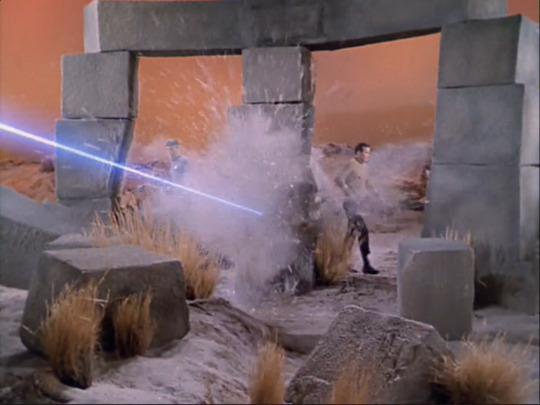
The very first phaser shot, as Professor Crater snipes at Kirk and Spock.

Kirk firing his phaser. Don’t worry, it’s set on “stun.”

Professor Crater getting struck by phaser fire. Don’t worry, it was set on “stun.” He’s going to talk like he’s drunk for the next few minutes.
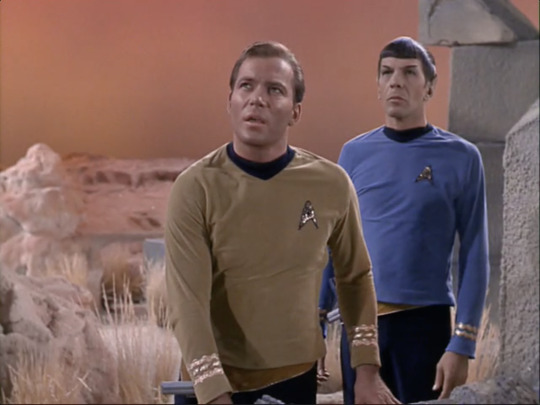

Kirk and Spock planetside, establishing that the two highest ranking officers will beam down alone to handle a dangerous situation. It’s not like they have an entire Security Department on board the ship.

The very first meeting in the Briefing Room.

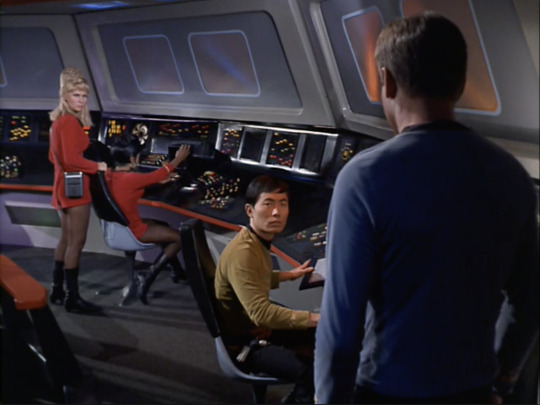

The crew at various stations on the bridge, although Uhura and Sulu are not at their usual posts, which just shows that this crew is highly competent and can handle multiple duties. Oh, and two of them happen to be women, and tow are people of color.

Sulu chiming in on the meeting via viewscreen.
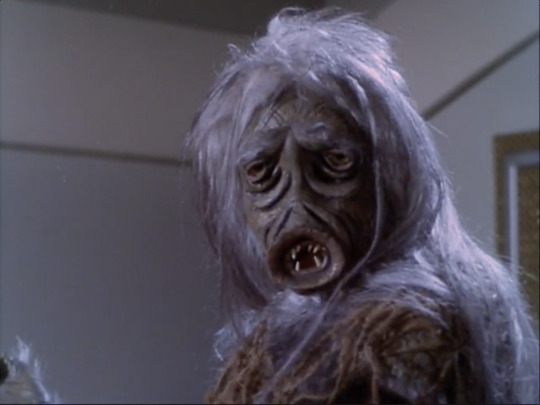
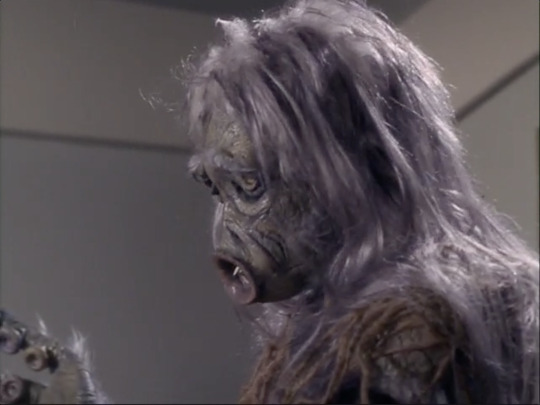

And then, because it was a science fiction television show in the 1960s, the network insisted there be a monster. So we got the salt vampire, the shape-changing creature that had been killing all sorts of people by sucking the salt out of their bodies. Not too scary by today’s standards, but I wouldn’t want to run into it in a dark alley.

The first time we get to see Kirk make that face as he screams in pain.
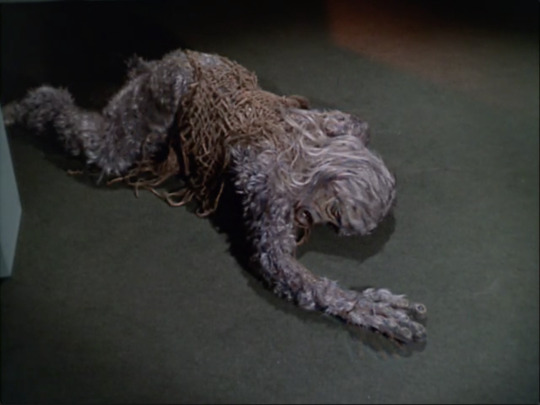
And the first time we see a dead monster/alien on the Enterprise.

The, finally, the what will become familiar denouement with everyone on the bridge as Kirk gives the order for the Enterprise to break orbit and proceed to its next assignment. Notice that Sulu has finally managed to make it to the helmsman’s station.

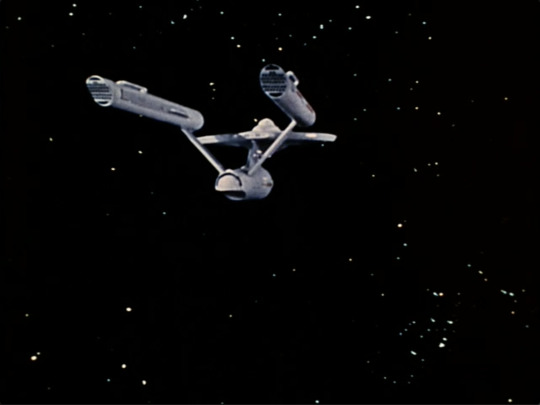
Headed off into space for another adventure next week!
1966 was a great year. It gave us Ultra Q. Ultraman, Ambassador Magma (aka The Space Giants), The New Adventures of Superman animated series, the Slurpee and, of course, Star Trek.
55 years later Star Trek is more popular than ever, with several new television series available, and another feature film in the works. Here’s hoping for another 55 years of exploring the galaxy!
#Star Trek: The Original Series#Star Trek Day#USS Enterprise#NCC-1701#Captain James T. Kirk#Mr. Spock#Dr. Bones McCoy#Lt. Sulu#Lt. Uhura#Yeoman Rand#Salt Vampire
109 notes
·
View notes
Link
Deer is one of the most commonly hunted animals within the United States. For good reason too, they’re the smallest and least elusive of the large game animals and the tags usually aren’t going to break the bank.
It’s not quite as simple as sitting in a stand waiting for them to walk under you though, many of those who oppose hunting have no idea just how much goes into properly filling the freezer with venison.
So let’s talk a little about some of the lesser known practices that can help you bag a buck.
Hunting Variations and Deer
There are, essentially, three types of deer hunting which are used. You don’t just walk into the woods with a rifle and find a deer, the way many people imagine.
The most common, undoubtedly, is that of blind hunting. It’s mostly used by rifle hunters and is the “good-ol-boy’s” favored method. If you’ve got access to the land for it, you’ll build a box blind in the off-season.
One of the main things people forget is that it is not the blind which needs to be hidden. It’s the movement within the blind while you’re lining up the shot. Ideally, you should have built it large enough you can rest your rifle and sandbag or bipod as you prefer without the barrel protruding. This is obvious to all but the most obvious of hunters, of course.
The second big thing which can go wrong with a blind is not painting the interior. You need an interior color which can hide you, because you’ll stick out like crazy moving against a plain wooden interior. If you wear old olive drab BDUs while hunting? Go with OD green and you can’t go wrong.
From here, you’ll need to be still and quiet and as long as you’ve set up in the right area you’ll be in good hands.
Stand hunting is often favored by bow hunters. In this case, you’ll find that safe construction of a stand and the ability to remain still for an extended period is your best friend. When it comes to this kind of hunting, your ability to choose a proper shooting lane is your best friend.
Stalk-and-spot hunting isn’t commonly used by many, rifle or bow. This will entail you moving very, very slowly through the woods. Remaining behind cover. Your glass will be your best friend in this case.
Did we mention moving slowly? Because a step every fifteen to thirty seconds isn’t uncommon once you’re in the right area. For bow hunters this is even more essential, due to the limited range of their weapon.
It’s an extremely difficult form of hunting to master. No hunting is really just walking into the woods with a weapon, but extremely rewarding. If you’re a complete novice to hunting, you may wish to try with less wary prey than deer, many of us started with small, fast game like rabbits and ground fowl before even attempting to move on to larger game.
Deer, in particular, are notoriously difficult to hunt in this way and success isn’t guaranteed for anyone but the virtual master.
3 Second SEAL Test Will Tell You If You’ll Survive A SHTF Situation
Deer Behavior
Deer are commonly seen as peaceful, kind of docile animals.
This is a huge misconception in hunting season. A doe or buck that gets even an inkling of a human being can be gone before you can blink. While the does with young you see in more urban areas aren’t super human shy, during the hunting season in areas where you are allowed they are extremely alert.
Sight
The senses of deer are very finely tuned, but often in quite different ways than people assume.
The primary difference between being “sharp” and being different, however, lies within their sight. Their eyes see in a completely different spectrum than humans, many people think their cheap woodland camo is going to keep them hidden well.
It will… from other humans. Certain dyes used in manufacturing clothing are actually ultraviolet reactive, and it’s common for this to be seen in much of the “hunting” gear you see at large. Always test your camo.
Use a black light, if it fluoresces then you may as well be glowing to the animals while you’re hunting. This is especially important when you’re hunting from within a blind.
There are products available to kill the optical brightening of these dyes, and they can be found readily online, so test and treat your gear.
Deer vision, apart from this remarkable quality is still not great, but here’s the thing… they lack visual acuity. Movement sense and their field of vision is actually still remarkable, but they’re not as “sharp” as humans which makes it a bit easier to hide your human form.
Smell
Their hearing and sense of smell, on the other hand, are remarkable. A deer can smell you from half a mile away, they also process smells much differently than we do.
This is why it’s so important to cover your scent trail in any way possible. One of the best is simply to make sure that you go through the usuals of covering your scent.
Thankfully, in most areas this isn’t as large of an advantage as you might imagine. Deer are wary, but no one would be bagging them if they bolted at the first sign of human scent. Do your best using the traditional methods and you should be fine.
Hearing
Deer hearing actually isn’t much better than a humans. They just tend to be more wary than a human, after all… you’re a big predator. If you hear a stick crack, you’re not likely to jump while out in the woods unless you’re already aware there’s a bigger predator in the area.
Deer, on the other hand, are constantly on the look-out for their predators.
They do have one distinct advantage however: their directional hearing is much better than ours. They can hear slightly higher on the scale than humans. A noise you’re likely to barely notice, a knife being slid slowly out of a sheath or a quietly moved bolt on a rifle, is enough to set most deer off.
What all of this sensory information really brings us to is one thing, however.
Awareness
Humans live in noisy environments. Even the best of us aren’t likely to be spooked by a slightly off noise. A trained human might be able to discern something really off, around us. A knife clicking open, a pistol being cocked, or quickening foot steps behind us, but even the average “aware” person isn’t going to immediately react to this.
Deer, on the other hand, aren’t just being hunted by us. They live their lives surrounded by predators in an environment with predictable noises. This means that the slightest thing off makes a deer wary, and something being really off will set them running.
Keeping this in mind, in addition to the sensory information above, is your key to understanding their behavior.
Basic Scouting
Most hunters with private land have a fairly predictable method. You make a blind, you plant food plots around the area in order to ensure that you attract deer, and then you’ll spend some time waiting in a blind during deer season.
When you’re on public land, or land which is improperly prepared things are different. Even if you’re not going for proper spot-and-stalk style hunting you still need to know where to set up your pop-up or temporary stand.
This means locating animal trails, water sources, and likely food sources for the animals in question. You’ll likely be spending a good amount of time in the woods even in the off-season in a new area.
Frankly, some of us get bored doing this after five or six trips. Grab a decent Gamo and bag some rabbits or tree squirrels if they’re in season while you’re doing it if you find it too boring, but keep in mind you’re learning their habits not just small game hunting.
You need to know not just habits, but also shooting lanes if you’re a rifle hunter.
Making the Kill
Shooting lanes are possibly the most important part of your making the kill. Look, if you’re not competent enough to hit the deer in the first place, you should be at the range and not in the woods.
A shooting lane means an area where you’ll have the distance a deer can’t quite detect you without obstruction. Don’t trust “brush guns”, I’ve seen .45-70 rounds deflect by up to six inches from hitting light bushes. If your area is too densely overgrown, then you may have to make some or rely on shooting from height.
Once you have a few established shooting lanes, whether from your blind or stand, it’s time to discuss the actual kill shot.
The Best Place to Shoot a Deer
There is always going to be debate about this aspect. The obvious goal is always one-shot one-kill. However, there’s a certain level of marksmanship which will go into each and every shot that you’ll make.
At less than 150 yards a competent rifleman, shooting at a still deer, can be taken in the head. This offers the best chance of the deer dropping either instantly or within five to ten feet. There three accepted ways to do this:
Brain shots are very hard to pull off. You basically fire between the tear ducts, instantly destroying the animal’s brain.
Secondly, by shooting behind the eyes you can instantly destroy most of the brain, usually dropping the animal almost instantly.
Lastly, a shot into the top four pieces of the spine, just below the base of the skull has much of the same effect.
Of course, not all hunters are expert riflemen, and I wouldn’t imply you need to be. The other commonly accepted shot is the “double-shoulder” shot. You are trying to shoot through the actual shoulder blade of the deer in question. This shot is usually done with a fairly large round, a .308 or .30-06 for example. In this case, the shot will generally lodge in the opposite shoulder blade, in effect this snaps the deer’s spine.
The typical “heart-lung” shot is perfectly viable as well. In this case you shoot through the front of the torso in the “boiler-room” area. This is perfectly viable, hard to miss, and with luck will drop the deer quickly enough you won’t have to give much chase.
As far as pros and cons go, it’s a pretty easy break down:
Head shots are an instant kill.A near miss can damage the jaw or miss the deer entirely, it’s only recommended for expert riflemen.
The shoulder shot is a big kill, and fairly easy to make. It does, however, damage a lot of meat since you’ll need to use a high caliber round to do it effectively.
The heart/lung shot is a reliable kill. It is not, however, always a fast kill and if only a single lung is damaged the deer may escape and even recover.
With a bow, you are nearly always best off taking the shot in a way that it goes through the heart and lungs. Arrows cause considerable tissue damage but lack the concussive force for a high shoulder kill and the probability of a head shot being both viable and accurate enough for it to matter is too risky to make it an ethical shot for anything but a chance encounter at fifteen yards or less with a powerful bow.
Common Mistakes
There are a lot of common mistakes that inexperienced hunters make, and to be honest most of them are drawn from misconceptions that people who’ve rarely been in the field make.
Not wearing blaze orange in deer season, especially on public land, is asking for trouble. Some hunters don’t follow safety rules, and taking a bullet wound is not worth the risk. Vests and hats should be a minimum, jackets are better.
Making tons of noise is also something common. Not just the obvious talking. Tighten knife sheathes in multiple areas to avoid “slapping.” Look for softer outer clothing to avoid scraping noises as well. Secure your pack as well as possible and if you must lean on something, then be careful getting off and on it in order to make sure you don’t make any “scraping” noises.
Always be aware of your surroundings.
And above all, this is the most common mistake I see people make: examine every piece of a failed hunt. Observe the routes you moved, the gear you used, and always question each and every possible misstep you made.
In many ways, a failed hunt can make you better at hunting than one where you got lucky.
That is what truly separates a good hunter from a failed one: the ability to analyze your mistakes. Hunting is an art, it is skill, and it is a constant learning process.
Learning to be a Better Hunter
Always learn about your quarry. Always sharpen your skills. Always examine your mistakes.
If you do all of these, you will find yourself progressing at a rate you never thought possible. You will fill tags season after season.
If you don’t, well, it’s no shame to just spend a couple of days in the woods with friends but don’t expect as much success as those who are constantly trying to better their skills.
Either way, happy hunting!
This article has been written as a guest author for Survivopedia by Kevin Steffey, the founder of Deer Hunting Field.
from Survivopedia
Don't forget to visit the store and pick up some gear at The COR Outfitters. How prepared are you for emergencies?
#SurvivalFirestarter #SurvivalBugOutBackpack #PrepperSurvivalPack #SHTFGear #SHTFBag
0 notes